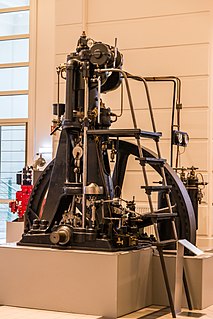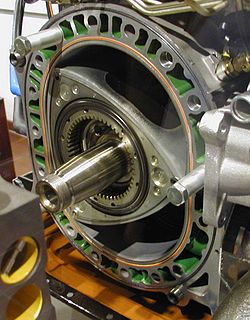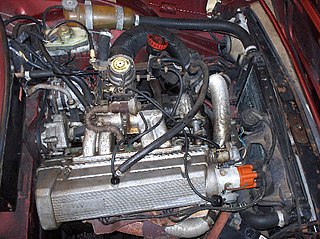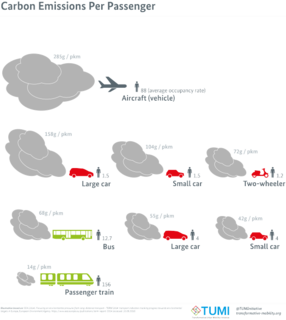
The diesel engine, named after Rudolf Diesel, is an internal combustion engine in which ignition of the fuel is caused by the elevated temperature of the air in the cylinder due to the mechanical compression ; thus, the diesel engine is a so-called compression-ignition engine. This contrasts with engines using spark plug-ignition of the air-fuel mixture, such as a petrol engine or a gas engine.

The Wankel engine is a type of internal combustion engine using an eccentric rotary design to convert pressure into rotating motion.

In internal combustion engines, exhaust gas recirculation (EGR) is a nitrogen oxide (NO
x) emissions reduction technique used in petrol/gasoline and diesel engines. EGR works by recirculating a portion of an engine's exhaust gas back to the engine cylinders. This dilutes the O2 in the incoming air stream and provides gases inert to combustion to act as absorbents of combustion heat to reduce peak in-cylinder temperatures. NO
x is produced in high temperature mixtures of atmospheric nitrogen and oxygen that occur in the combustion cylinder, and this usually occurs at cylinder peak pressure. Another primary benefit of external EGR valves on a spark ignition engine is an increase in efficiency, as charge dilution allows a larger throttle position and reduces associated pumping losses.

Petrol engine or gasoline engine is an internal combustion engine with spark-ignition, designed to run on petrol (gasoline) and similar volatile fuels.
Fuel efficiency is a form of thermal efficiency, meaning the ratio of effort to result of a process that converts chemical potential energy contained in a carrier (fuel) into kinetic energy or work. Overall fuel efficiency may vary per device, which in turn may vary per application, and this spectrum of variance is often illustrated as a continuous energy profile. Non-transportation applications, such as industry, benefit from increased fuel efficiency, especially fossil fuel power plants or industries dealing with combustion, such as ammonia production during the Haber process.

The Mercedes-Benz B-Class is a subcompact executive MPV manufactured and marketed by Mercedes-Benz since 2005, and now in its third generation.

Gasoline direct injection (GDI), also known as petrol direct injection (PDI), is a mixture formation system for internal combustion engines that run on gasoline (petrol), where fuel is injected into the combustion chamber. This is distinct from manifold fuel injection systems, which inject fuel into the intake manifold.
Manifold vacuum, or engine vacuum in an internal combustion engine is the difference in air pressure between the engine's intake manifold and Earth's atmosphere.
Shell Eco-marathon is a world-wide energy efficiency competition sponsored by Shell. Participants build automotive vehicles to achieve the highest possible fuel efficiency. There are two vehicle classes within Shell Eco-marathon: Prototype and UrbanConcept. There are three energy categories within Shell Eco-marathon: battery-electric, hydrogen fuel cell, and internal combustion engine. Prizes are awarded separately for each vehicle class and energy category. The pinnacle of the competition is the Shell Eco-marathon Drivers' World Championship, where the most energy-efficient UrbanConcept vehicles compete in a race with a limited amount of energy.
Gasoline gallon equivalent (GGE) or gasoline-equivalent gallon (GEG) is the amount of alternative fuel it takes to equal the energy content of one liquid gallon of gasoline. GGE allows consumers to compare the energy content of competing fuels against a commonly known fuel—gasoline. GGE also compares gasoline to fuels sold as a gas and electricity.

Variable-geometry turbochargers (VGTs), occasionally known as variable-nozzle turbines (VNTs), are a type of turbochargers, usually designed to allow the effective aspect ratio of the turbocharger to be altered as conditions change. This is done because the optimum aspect ratio at low engine speeds is very different from that at high engine speeds.

A gyrobus is an electric bus that uses flywheel energy storage, not overhead wires like a trolleybus. The name comes from the Greek language term for flywheel, gyros. While there are no gyrobuses currently in use commercially, development in this area continues.

A diesel generator (DG) is the combination of a diesel engine with an electric generator to generate electrical energy. This is a specific case of engine-generator. A diesel compression-ignition engine is usually designed to run on diesel fuel, but some types are adapted for other liquid fuels or natural gas.
Bergen Engines AS is a diesel engine manufacturer based in Bergen, Norway, part of Rolls-Royce Power Systems. It makes various ranges of diesel engines for the marine sector. There are three "Bergen" and two Crossley Pielstick ranges with power outputs in the range 1.2MW to 15MW. Formerly part of Rolls-Royce Marine Power Operations, it was merged into Tognum in July 2013, after Tognum had become a 50/50 joint venture between Rolls-Royce and Daimler AG.

The fuel economy of an automobile relates distance traveled by a vehicle and the amount of fuel consumed. Consumption can be expressed in terms of volume of fuel to travel a distance, or the distance travelled per unit volume of fuel consumed. Since fuel consumption of vehicles is a significant factor in air pollution, and since importation of motor fuel can be a large part of a nation's foreign trade, many countries impose requirements for fuel economy. Different methods are used to approximate the actual performance of the vehicle. The energy in fuel is required to overcome various losses encountered while propelling the vehicle, and in providing power to vehicle systems such as ignition or air conditioning. Various strategies can be employed to reduce losses at each of the conversions between the chemical energy in the fuel and the kinetic energy of the vehicle. Driver behavior can affect fuel economy; maneuvers such as sudden acceleration and heavy braking waste energy.

The energy efficiency in transport is the useful travelled distance, of passengers, goods or any type of load; divided by the total energy put into the transport propulsion means. The energy input might be rendered in several different types depending on the type of propulsion, and normally such energy is presented in liquid fuels, electrical energy or food energy. The energy efficiency is also occasionally known as energy intensity. The inverse of the energy efficiency in transport, is the energy consumption in transport.

Energy-efficient driving techniques are used by drivers who wish to reduce their fuel consumption, and thus maximize fuel efficiency. The use of these techniques is called "hypermiling".

The Am 4/6 1101 was the world's first gas turbine-electric locomotive. It was built for the Swiss Federal Railways (SBB-CFF-FFS) by Brown, Boveri & Cie (BBC) in 1938 and used for experimental services on non-electrified lines.

Miles per gallon gasoline equivalent is a measure of the average distance traveled per unit of energy consumed. MPGe is used by the United States Environmental Protection Agency (EPA) to compare energy consumption of alternative fuel vehicles, plug-in electric vehicles and other advanced technology vehicles with the energy consumption of conventional internal combustion vehicles rated in miles per U.S. gallon.
Brake-specific fuel consumption (BSFC) is a measure of the fuel efficiency of any prime mover that burns fuel and produces rotational, or shaft power. It is typically used for comparing the efficiency of internal combustion engines with a shaft output.















